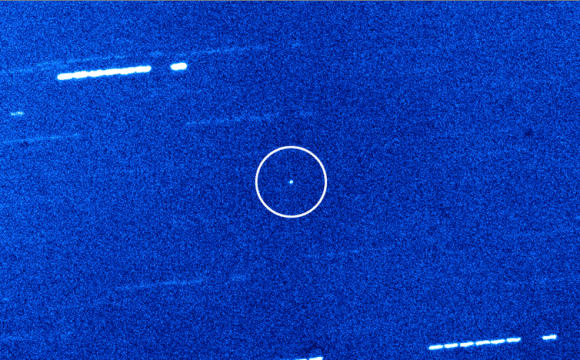On October 19th, 2017, the Panoramic Survey Telescope and Rapid Response System-1 (Pan-STARRS-1) in Hawaii announced the first-ever detection of an interstellar object, named 1I/2017 U1 (aka. ‘Oumuamua). After originally hypothesizing that it was a comet, observations performed by the European Southern Observatory (ESO) and other astronomers indicated that it was likely a strange-looking asteroid measuring about 400 meters (1312 ft) long.
Since that time, multiple surveys have been conducted to determine the true nature of this asteroid, which have included studies of its composition to Breakthrough Listen‘s proposal to listen to it for signs of radio transmissions. And according to the latest findings, it seems that ‘Oumuamua may actually be more icy than previously thought (thus indicated that it is a comet) and is not an alien spacecraft as some had hoped.
The first set of findings were presented in a study that was recently published in the scientific journal Nature, titled “Spectroscopy and thermal modelling of the first interstellar object 1I/2017 U1 ‘Oumuamua“. The study was led by Alan Fitzsimmons of Queen’s University Belfast, and included members from The Open University in Milton Keynes, the Institute for Astronomy (IfA) at the University of Hawaii, and the European Southern Observatory (ESO).

As they indicate in their study, the team relied on information from the ESO’s Very Large Telescope in Chile and the William Herschel Telescope in La Palma. Using these instruments, they were able to obtain spectra from sunlight reflected off of ‘Oumuamua within 48 hours of the discovery. This revealed vital information about the composition of the object, and pointed towards it being icy rather than rocky. As Fitzsimmons explained in op-ed piece in The Conversation:
“Our data revealed its surface was red in visible light but appeared more neutral or grey in infra-red light. Previous laboratory experiments have shown this is the kind of reading you’d expect from a surface made of comet ices and dust that had been exposed to interstellar space for millions or billions of years. High-energy particles called cosmic rays dry out the surface by removing the ices. These particles also drive chemical reactions in the remaining material to form a crust of chemically organic (carbon-based) compounds.”
These findings not only addressed a long-standing question about ‘Oumuamua true nature, it also addresses the mystery of why the object did not experience outgassing as it neared our Sun. Typically, comets experience sublimation as they get closer to a star, which results in the formation of a gaseous envelope (aka. “halo”). The presence of an outer layer of carbon-rich material would explain why this didn’t happen ‘Oumuamua.
They further conclude that the red layer of material could be the result of its interstellar journey. As Fitzsommons explained, “another study using the Gemini North telescope in Hawaii showed its color is similar to some ‘trans-Neptunian objects’ orbiting in the outskirts of our solar system, whose surfaces may have been similarly transformed.” This red coloring is due to the presence of tholins, which form when organic molecules like methane are exposed to ultra-violet radiation.
Similarly, another enduring mystery about this object was resolved thanks to the recent efforts of Breakthrough Listen. As part of Breakthrough Initiatives’ attempts to explore the Universe and search for signs of Extra-Terrestrial Intelligence (ETI), this project recently conducted a survey of ‘Oumuamua to determine if there were any signs of radio communications coming from it.
While previous studies had all indicated that the object was natural in origin, this survey was more about validating the sophisticated instruments that Listen relies upon. The observation campaign began on Wednesday, December 13th, at 3:00 pm EST (12:00 PST) using the Robert C. Byrd Greenbank Radio Telescope, the world’s premiere single-dish radio telescope located in West Virginia.
The observations period was divided into four “epochs” (based on the object’s rotational period), the first of which ran from 3:45 pm to 9:45 pm ET (12:45 pm to 6:45 pm PST) on Dec 13th, and last for ten hours. During this time, the observation team monitored ‘Oumuamua across four radio bands, ranging from the 1 to 12 GHz bands. In addition to calibrating the instrument, the survey accumulated 90 terabytes of raw data over after observing ‘Oumuamua itself for two hours.
The initial results and data were released last week (Dec. 13th) and are available through the Breakthrough Listen archive. As Andrew Siemion – the Director of Berkeley SETI Research Center who took part in the survey – indicated in a Breakthrough Initiatives press release:
“It is great to see data pouring in from observations of this novel and interesting source. Our team is excited to see what additional observations and analyses will reveal”.
So far, no signals have been detected, but the analysis is far from complete. This is being conducted by Listen’s “turboSETI” pipeline, which combs the data for narrow bandwidth signals that are drifting in frequency. This consists of filtering out interference signals from human sources, then matching the rate at which signals drift relative to the expected drift caused by ‘Oumuamua’s own motion.
In so doing, the software attempts to identify any signals that might be coming from ‘Oumuamua itself. So far, data from the S-band receiver (frequencies ranging from 1.7 to 2.6 GHz) has been processed, and analysis of the remaining three bands – which corresponds to receivers L, X, and C is ongoing. But at the moment, the results seem to indicate that ‘Oumuamua is indeed a natural object – and an interstellar comet to boot.
This is certainly bad news for those who were hoping that ‘Oumuamua might be a massive cylinder-shaped generation ship or some alien space probe sent to communicate with the whales! I guess first contact – and hence, proof we are NOT alone in the Universe – is something we’ll have to wait a little longer for.
Further Reading: The Conversation, Nature, Breakthrough Initiatives


